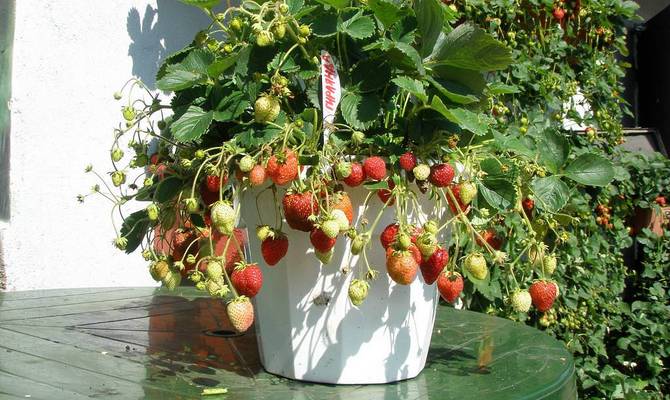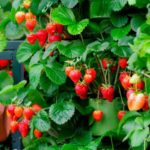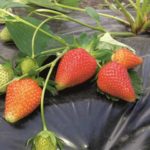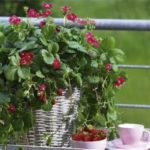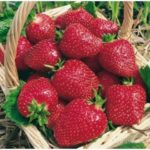At present, ampelous varieties of large-fruited strawberries are rapidly gaining popularity, which give a tasty and very rich harvest. In addition, with proper care, such plants can become an unusual decoration for the garden and home. Still would! After all, the berry can be planted at home even in winter, and the flowers of its unusual pink color.
Table of contents
What is a strawberry strawberry?
The name of this species came from the German language, from which the word "ampel" is translated as a lamp.That is, initially, such plants were perceived as decorative elements, which are grown in flower pots and pots and hung from the ceiling like a light bulb.
Ampiel strawberry has a number of features that make gardeners all over the world fall in love with it so much:
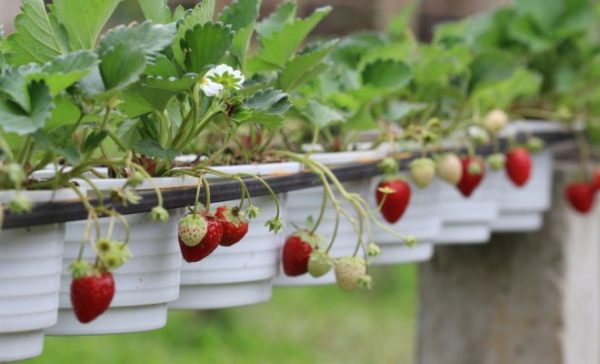
- The main difference from other varieties is that such garden strawberries bear fruits on both peduncles and whiskers at the same time;
- Most varieties of ampelous strawberry remontanttherefore, the harvest can be obtained throughout the growing season;
- This group includes varieties intended for vertical cultivation, with which you can decorate the house and get a harvest of tasty and juicy berries. Even urban residents can grow this berry by placing it on a balcony or windowsill;
- Many varieties feel good with a small amount of lighting.
The main difficulties that the gardener may face will be individual placement and frequent transplants:
- when growing seedlings, the strawberry strawberries are planted on separate beds and not mixed with other species;
- Every 2-3 years, the bush must be transplanted into fresh, fertile soil with a large amount of fertilizer, otherwise the berries will begin to shrink, and the plant will lose its basic properties.
Popular varieties
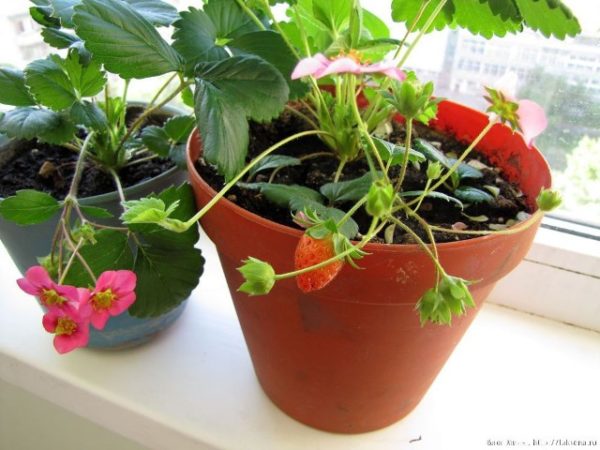
- Tuscany - This variety was bred relatively recently, but already enjoys great popularity among gardeners around the world. Compact bushes, the height and width of which is equal to 25-30 centimeters, release long shoots, the size of 1 meter. The yield is very high, large, ruby fruits are cone-shaped, elongated in shape and have excellent taste and aroma. Such a plant will be a wonderful decoration anywhere, and the fruits obtained are unlikely to leave anyone indifferent;
- Homemade delicacy - Another decorative variety of ampelous strawberry, which can be grown in pots or special pots. Powerful and dense foliage of dark green color favorably emphasizes small bright red berries of a cone-shaped form. They have an excellent aroma and slightly sour taste;
- Queen Elizabeth 2 - the bush of this variety is very powerful and strong, the berries are large, their weight can reach 40 grams. The fruits have the correct cone-shaped shape, are painted in a rich red color, the skin is smooth and shiny. The flesh is firm and juicy, the taste is excellent. Fruiting can be repeated up to 2-3 times per season. Queen Elizabeth 2 needs to be replanted every 1.5 years;
- Cletter star - this variety has excellent resistance to drought and frost, can winter without shelter. The bush is compact, forms a large number of whiskers. Peduncles high, but under the weight of the berries they bend down. The fruits are very juicy and tasty, characterized by a large size (one berry can weigh up to 60 grams). The skin of a strawberry is bright red, and the flesh is thick. Characterized by the presence of a strong flavor;
- Fresco - The period of fruiting is stretched from June to September. On a small, compact bush many inflorescences are formed, which bring a rich harvest. The berries are not large, on average, their weight is 20 grams. They have a pleasant sweet-sour taste and strong aroma, the flesh is dense and juicy. This variety tolerates temperature fluctuations and is immune to many diseases.
- Homemade delicacy
- Cletter star
- Queen Elizabeth 2
- Tuscany
- Fresco
How to plant a berry?
Amppelnaya strawberry is a rather unusual plant that is grown in pots or in open ground. Most often from it create a variety of compositions that can decorate any room or garden. Regardless of where such strawberries will be grown, it is necessary to make a fertile soil mixture consisting of:
- 4 pieces of turf land;
- 2 pieces of peat;
- 1 part of large river sand.
To improve the fertility of the soil before planting it can be further fed with organic fertilizers.
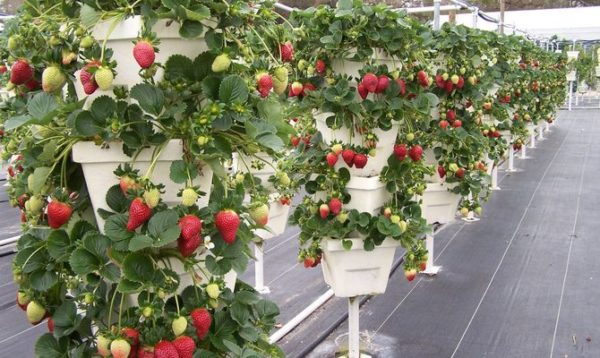
Most often, strawberry strawberries are planted in the summer, in a period that lasts from mid-June until the end of August. There are several ways to accommodate this interesting shrub.
The most common option is the cultivation of strawberries in pots or pots:
- In order for the plant to feel comfortable, the depth and diameter of the tank must be 30 centimeters;
- Initially, a thin layer of drainage consisting of expanded clay, pebbles or broken bricks is poured into the bottom of the pot, then the ground is laid on top of it;
- The seedling is placed in a container, gently added dropwise with earth and watered abundantly.
When using this method, the whiskers will smoothly go down. They look especially beautiful during flowering or fruiting.
Growing ampelous strawberries in the open field allows you to come up with many ways to place it. Many gardeners tie a mustache to a trellis or low fence. The main rule that should be taken into account when such a planting is to maintain the distance between the bushes, it should be at least 30-35 centimeters.
Also very popular landing in the form of a pyramid. To do this, make three drawers with a depth of 30-40 centimeters, while the length and width of the first one must be 1 meter, the second 60 centimeters, and the third 20 centimeters. The containers are filled with soil and put on each other, after which strawberries are planted in them.
Regardless of the planting pattern, the final stage will be abundant watering of the plants.
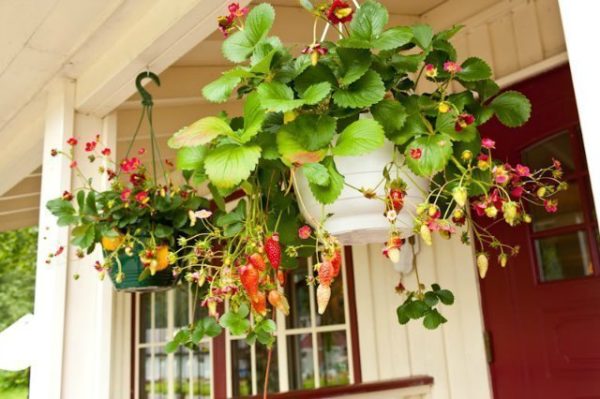
Plant care
Amppelnaya strawberry is considered unpretentious plant, therefore, its cultivation will be under the force, as a novice gardener, and professional. However, this culture also has its own characteristics that must be considered when growing it. First of all, it should be noted that such plants do not tolerate heat and direct sunlight, therefore, in too hot days they need to be further shaded.
Water the plant twice a day, using a small amount of water. When growing berries, it is very important to maintain a balance, the soil should be constantly hydrated, but the stagnation of moisture is not welcome.
Feed the plant once a month, using a mixture consisting of minerals diluted in water, taken in equal proportions:
- superphosphate;
- potassium permanganate;
- boric acid;
- ammonium nitrate;
- copper;
- zinc.
If strawberries are grown at home, it must be self-pollinated. There are several ways to perform these actions:
- Pollen is collected on a brush and transferred to a flower;
- Two flowers that are next to incline to each other;
- You can also use a fan that is directed to the plant.
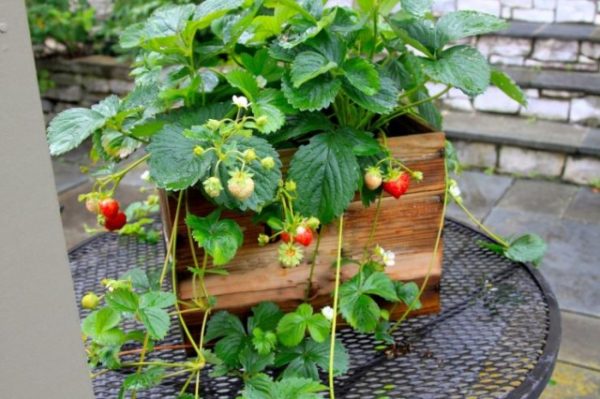
Pruning
An important aspect in the cultivation of berries will be correct and timely pruning, with which you can achieve the best yield:
- To increase the number of fruits, the first flower stalks are recommended to be completely removed;
- Experienced gardeners recommend keeping no more than 5 whiskers on a plant, in which case it will yield more yield;
- After receiving the first berries need to cut the lower leaves and flowering buds of the plant.
Preparing for winter at home
Even despite the fact that such strawberries have good frost resistance, it still needs to be prepared for winter:
- The best way of wintering will be transfer of bushes from open ground to the room, in this case the risk that the plant will freeze will be reduced to a minimum;
- If the strawberry remains to winter in the open ground, then the mustache is removed from the support and laid on the ground, then covered with spruce leaves, polyethylene, burlap or any other material.
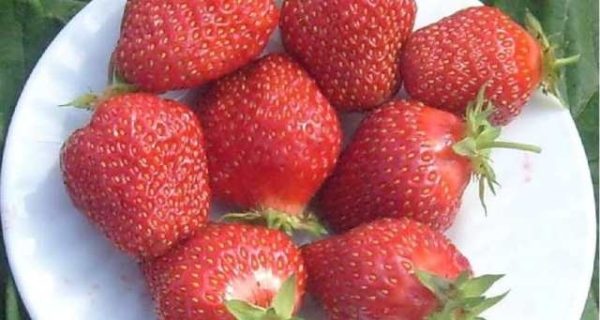
Diseases and pests of the repair berry
Amppelnaya strawberry is a favorite place of various insects.Most often, it is possible to meet strawberry mite or nematode.
When the strawberry mite appears, the berries wither and shrink and fade. To get rid of the pest, the plant is treated three times with special preparations (Nero, Fufanon, Aktellik, etc.) with an interval of 7-10 days. If the therapy does not help, it is necessary to cut off all foliage from the bush and burn it.
When the nematode berries harden, and the stems become thick and short. In this case, it is impossible to cure the plant, it is immediately dug up and burned.
Also ampelous strawberries can pick up fungal diseases, which can be eliminated only by using various fungicides. The evidence in this case is that the berry is treated twice a year, in spring and autumn it is treated with Brod's liquid.
Amppelnaya strawberry is a very interesting and unusual plant that can be grown in the open field and at home. The main advantage of the subspecies will be abundant fruiting, which is due to the fact that the berries are formed on the peduncles and on the whiskers.
